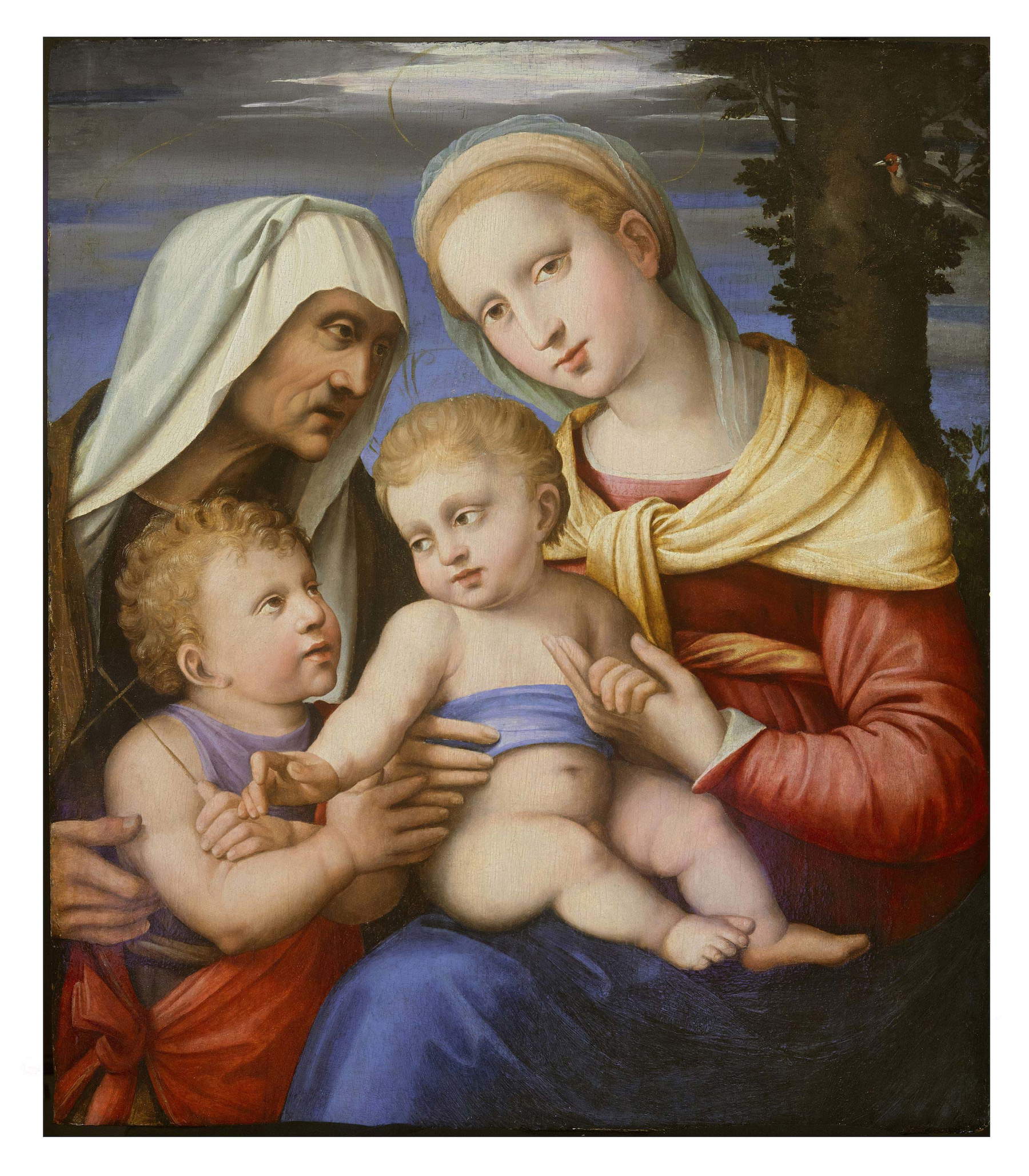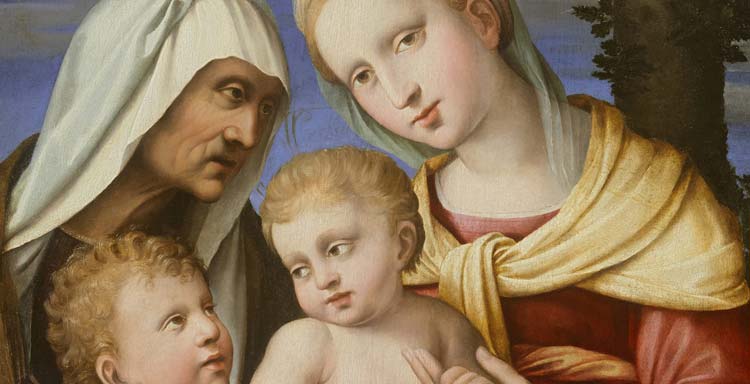Here we go again: another artificial intelligence attributing a painting of at least secondary importance to a genius, juxtaposed with whom it can only look ugly and clumsy. After the tondo de Brécy, a copy of Raphael’s Sistine Madonna, which software attributed to the Urbinate’s hand, now another artificial intelligence has attributed an even more improbable painting to the Sanzio genius. The work in question is a panel purchased in 1995 by an amateur painter in the United States: it is a painting that has objectively nothing to do with Raphael and is reminiscent, if anything, of the manner of Puligo or of artists who gravitated around him, such as Giovanni Battista Verrocchi, an artist of little significance who worked around the mid-sixteenth century with works on the borderline between art and craft. According to David Pollack, Sotheby’s Old Master specialist, it may be a work by Antonio del Ceraiolo, a 16th-century Florentine artist who trained in the workshop of Ridolfo del Ghirlandaio and tried, like so many others of his time, to imitate the style of Raphael. The painting’s owner, however, has always been convinced that the work was by a great master and has spent thousands of dollars in analysis and appraisals to try to get it attributed to some big name. And now he finally got satisfaction -- from artificial intelligence.
The story is told by the Wall Street Journal: the painting’s owner, one Anthony Ayers, an amateur painter and cabinetmaker from Chicago, noticed the work in 1995 while on vacation in England, in an antique store, where the owner suggested to him that it might be a Renaissance work. “Renaissance,” however, does not mean “by a great master” as common sense would suggest, since an army of excellent artists, good and poor, worked in the Renaissance alongside Raphael and Leonardo. Ayers “was not an art historian,” the WSJ recalls, but he was sufficiently intrigued to buy the work for the sum of a whopping $30,000 (ridiculous for a Raphael painting, in line instead with the quotations of Puligo, Antonio del Ceraiolo and other similar artists), and soon wanted to convince himself that he had found a painting by Raphael, something that would change his life, since, if it really had been a painting by the Urbinate, the value would have multiplied at least a thousandfold.

Ayers therefore embarked on a “quest that consumed him for decades,” the WSJ recalled: over time he rounded up some 40 friends and acquaintances who collectively spent more than $500,000 trying to uncover the painting’s history and identify its author (and now all hold a share of the property). The only discovery of any significance made by Ayers, however, was the work’s nineteenth-century provenance: the store owner told him it had belonged to a women’s convent in Kentucky, which had sold it in the 1980s. Ayers visited the convent and discovered that the work had come to Kentucky through French-American prelate Benedict Joseph Flaget, bishop of Louisville from 1808 to 1839, who donated the painting to the convent. It is not known, however, how the painting came to Flaget. And yet, in his honor, it was renamed Madonna Flaget. Then there was no shortage of technical analysis: diagnostic results found that the support and materials are compatible with what was used in Florence in the early 16th century.
Of course, the WSJ reminds us that “art historians disagree that Mr. Ayers’ discovery is a real Raphael.” But you don’t need art historians here: just be aware of Raphael’s paintings and look at the painting in question. The owner, not giving up, finally turned to Art Recognition, a Zurich-based company that uses artificial intelligence to analyze artists’ brushstrokes: the verdict of the “expertise” entrusted to the software is that there would be a 97 percent probability that the faces of Jesus and Mary in the work were painted by Raphael, and that the rest of the panel may have been completed by a workshop collaborator.
The CEO of Art Recognition let the WSJ know that her team used algorithms through which the painting was compared with more than 100 digital images of Raphael’s works and “fakes” to arrive at the result obtained, which would, moreover, be quite rare according to her, since less than 10 percent of the works that are submitted to the program produce a positive identification with a probability of more than 95 percent. Cooling the enthusiasm, however, came from restorer Karen Thomas, who worked on the painting in 2019 giving it its current appearance (it was in fact quite ruined when it was purchased by Ayers): “I’m afraid people will see the computer as flawless, but it’s just another tool, not a smoking gun,” she told the WSJ. Thomas added that computers can probably recognize the texture of brushstrokes better than the naked eye, but he wonders if machines can account for paint that has been worn away and other factors related to the condition of a work, as scholars do.
Among the latter, to speak out with a clear name for now is only David Pollack, who revealed that his auction house receives more than a thousand requests for appraisals each year from collectors who have anonymous works and often hope that their pieces can be attributed to a great master, such as Raphael or Leonardo. But in his view there seems to be no chance that the work is by Raphael, despite the fact that he has not commented on the results of the algorithm. The WSJ then quotes an American art history teacher, Patricia Trutty-Coohill, an instructor at Siena College (a Franciscan college in Loudonville, New York), who despite having no scholarly qualifications on Raphael spoke in favor of the attribution as early as 1997. In contrast, the only Raphael expert mentioned, Jürg Meyer zur Capellen, gave a negative opinion in 1999. It is then known that Christie’s agreed to sell the painting in 2001, but only if it was auctioned with attribution to the Ceraiolo. Needless to say, Ayers and his friends refused. And now the matter gets more complicated anyway because a group of people is behind the painting who have invested, and not a little either. And, the WSJ points out, “they cannot allow it to be attributed to anyone other than Raphael.” How now to tell these people that perhaps theirs was not a good investment, despite the fact that the results of artificial intelligence may give them a modicum of hope? Now their only hope is that, following the computer’s response, a debate can be rekindled. And for now, the picture remains locked in the vault of a Chicago bank.
 |
| Here we go again: according to Artificial Intelligence, this painting is by Raphael |
Warning: the translation into English of the original Italian article was created using automatic tools. We undertake to review all articles, but we do not guarantee the total absence of inaccuracies in the translation due to the program. You can find the original by clicking on the ITA button. If you find any mistake,please contact us.